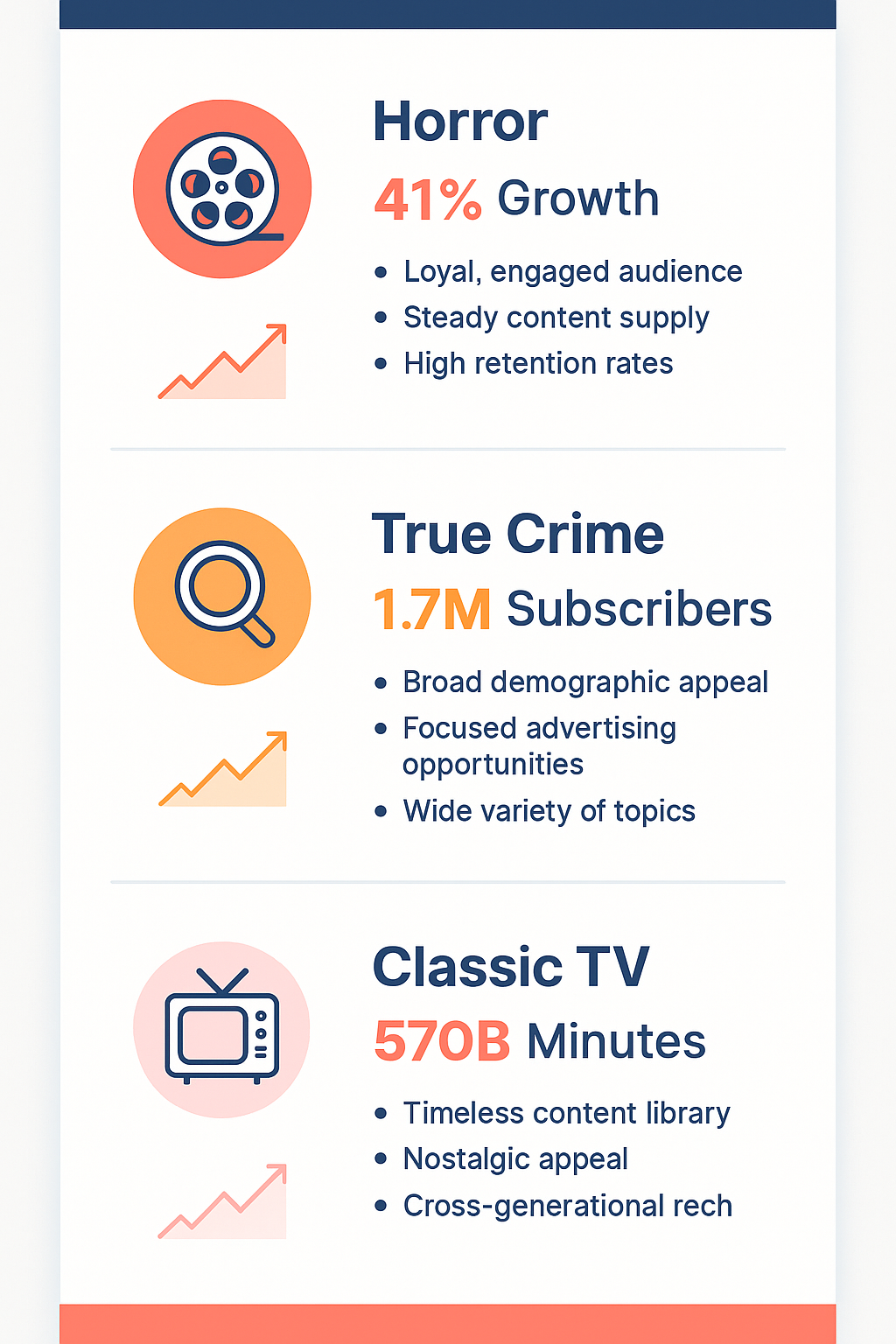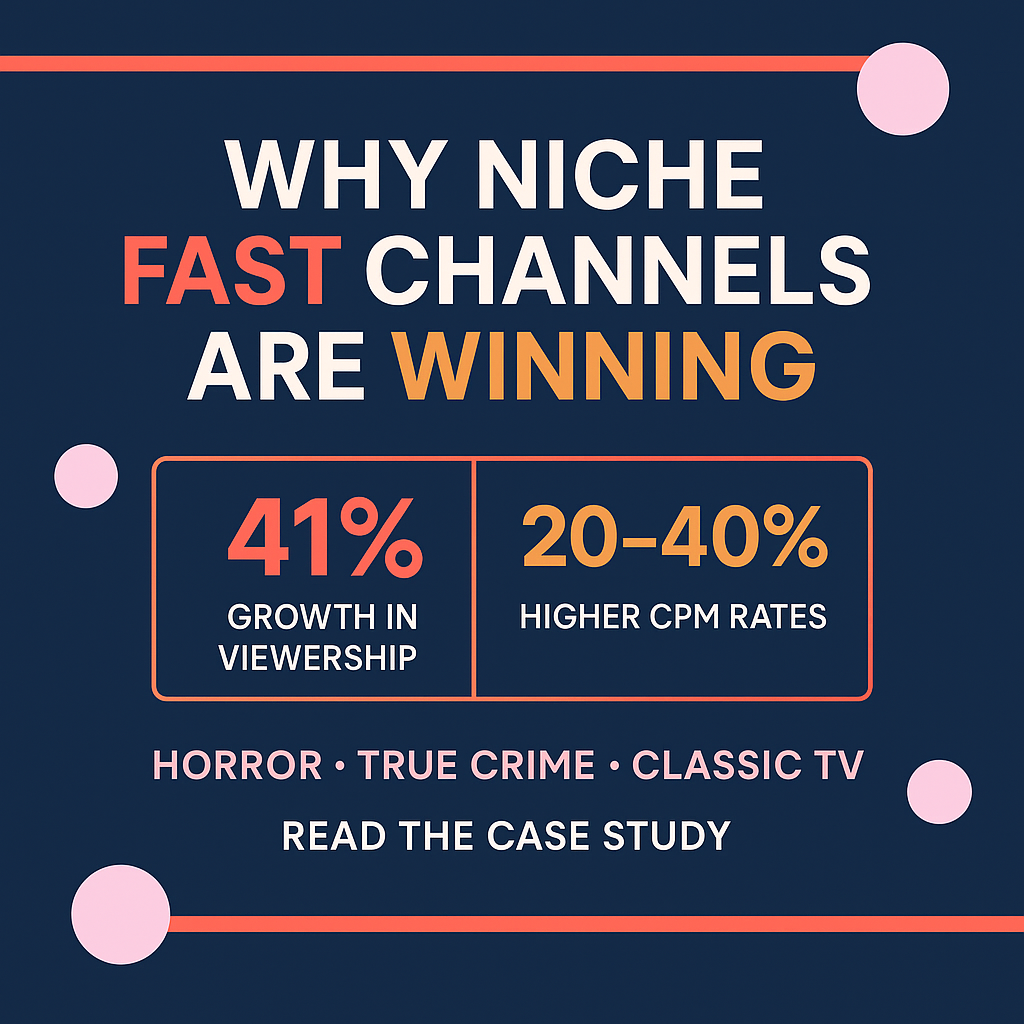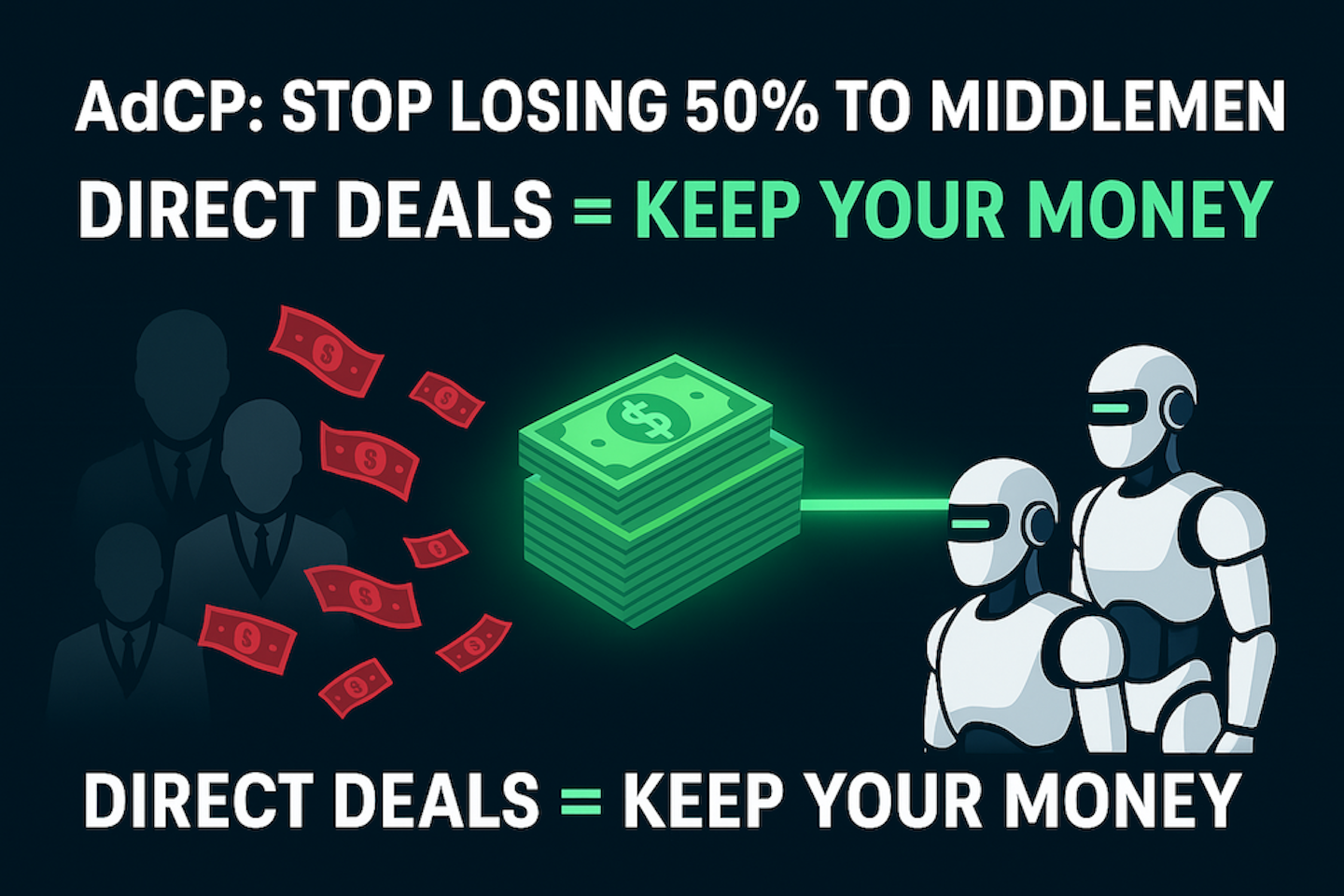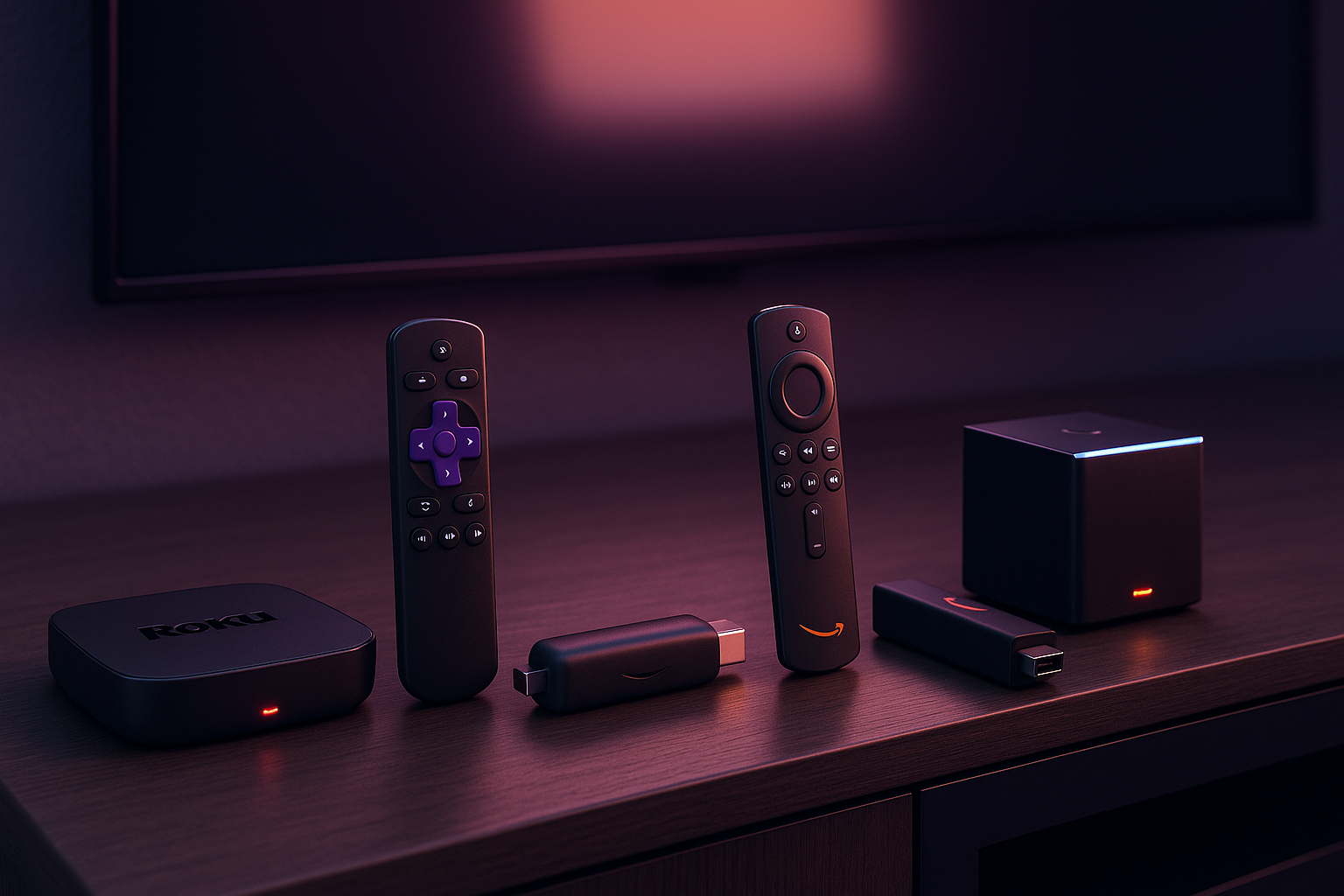Why Niche FAST Channels Are Outperforming Broad Content (Case Study: Horror, True Crime, and Classic TV)
The FAST (Free Ad-Supported Streaming TV) landscape is experiencing a fascinating shift. While conventional wisdom suggests casting the widest net possible, the global FAST market now features over 1,900 individual channels, and the channels seeing the strongest performance aren’t the ones trying to be everything to everyone. They’re doubling down on niche content.
If you’re a publisher considering launching a FAST channel or rethinking your content strategy, the data tells a compelling story: targeted, vertical channels are consistently outperforming their broad-appeal counterparts in viewership, engagement, and revenue generation.
The Niche Advantage: Why Specificity Wins
The traditional broadcast model trained us to think bigger is better. But in January 2025, viewers in the U.S. spent a combined 4.7% of their total TV time watching content on The Roku Channel, Tubi and Pluto TV—representing a 41% increase since January 2024 (https://gracenote.com/insights/nostalgia-no-more-fast-channels-are-redefining-free-streaming-tv/). What’s driving this growth? Targeted content that speaks directly to specific audience interests.
Think about your own streaming behaviour. You’re more likely to commit to a channel that consistently delivers content you love rather than scrolling endlessly through a generic entertainment mix. FAST channels with expansive and often niche content libraries are attracting audiences that traditional TV channels have been losing.
Niche FAST channels offer distinct advantages that broad content simply cannot match. Viewer retention runs significantly higher because audiences know exactly what they’re getting and return consistently. Advertisers find these channels particularly appealing because brands can target specific demographics with precision, leading to better campaign performance. Content acquisition costs often prove lower for focused libraries, as rights holders offer better licensing terms for targeted distribution. Platform recommendation engines favour consistent content themes, meaning niche channels benefit from better algorithmic performance. Perhaps most importantly, niche audiences become advocates who drive organic growth through word-of-mouth and social sharing.

Case Study: Horror Channels Thrive in Specificity
Horror proves that vertical content strategies work. FilmRise has launched several new true crime series specifically for FAST channels (https://www.mediaplaynews.com/filmrise-launches-several-new-true-crime-series-on-fast-channels-apps/), recognising the audience demand for genre-specific programming. Horror fans are passionate, dedicated viewers who actively seek out new channels in their genre.
The horror niche demonstrates several success factors. First, horror content has evergreen appeal—classic horror films from the 1960s through the 1980s continue attracting both nostalgic viewers and new generations discovering them for the first time. Second, horror attracts highly engaged audiences with strong retention rates. Viewers who start a horror movie typically finish it, driving up crucial watch-time metrics that determine ad revenue.
Ad breaks can command CPMs 20-40% higher than traditional linear reruns, thanks to the value of targeted advertising (https://www.advanced-television.com/2025/07/08/the-age-of-evergreen-why-classic-content-thrives-in-fast/). Horror channels benefit from this premium because advertisers know exactly who they’re reaching: typically 18-49 year olds with disposable income and strong brand loyalty.
The production value requirements for horror content also work in publishers’ favour. While you’d struggle to compete with Netflix on big-budget drama, a well-curated horror channel featuring classic films, B-movies, and cult favourites can build a passionate following without massive content investments.
True Crime: The Obsession That Drives Viewership
True crime represents perhaps the ultimate niche success story in streaming. True crime channels on YouTube have drawn millions into a rabbit hole of real-life horror, with channels like Lazy Masquerade reaching over 1.7 million subscribers (https://podcastle.ai/blog/true-crime-youtube-channels/). This obsession translates seamlessly to FAST channels.
True crime viewers exhibit remarkable behavioural patterns that make them ideal for the FAST model. They binge-watch content, spending hours exploring cases and related stories. They actively seek new content, making discovery easier. They tolerate—and even appreciate—advertising breaks that don’t disrupt narrative flow. And they share content within their communities, driving organic growth.
The true crime audience also skews toward higher-value demographics. Viewers tend to be educated, employed professionals—primarily women aged 25-54—who represent premium advertising targets. This demographic profile allows true crime channels to command higher CPMs than general entertainment channels.
Content acquisition for true crime channels offers strategic advantages. Extensive libraries of true crime documentaries, court TV coverage, and investigative series exist in catalogue libraries, often available at reasonable licensing rates. You can also supplement with news footage, archival content, and lower-budget original productions that true crime audiences enthusiastically consume.
Classic TV: Nostalgia Meets New Discovery
TV content from 2000-2018 drives the most time spent on streaming platforms, with the 10 most-watched licensed TV shows driving more than 570 billion viewing minutes—more than double the viewing minutes spent watching top originals and movies combined (https://gracenote.com/insights/nostalgia-no-more-fast-channels-are-redefining-free-streaming-tv/). This appetite for familiar content has created a goldmine for classic TV FAST channels.
The classic TV strategy works on multiple levels. Baby Boomers and Gen X viewers seek comfort in shows they grew up watching—programmes like The Andy Griffith Show, I Love Lucy, and The Brady Bunch. These viewers often “watch” classic TV as background content whilst working from home or doing household tasks, making the linear FAST model ideal for their consumption habits.
Simultaneously, younger viewers are discovering these shows for the first time. Gen Z audiences are exploring classic sitcoms, finding humour and cultural context that feels fresh precisely because it’s different from today’s content. Gen Z viewers are discovering retro favourites for the first time, adding a fresh wave of enthusiasm that complements the nostalgia-driven rewatch habits of Boomers.
The business case for classic TV channels is equally compelling. Content costs remain relatively low—many classic shows have fully depreciated, and rights holders are eager for new revenue streams. These titles are usually fully owned or already recouped, offering instant recognition with no need to explain or build new buzz. Production requirements are minimal since you’re simply programming existing content. And the advertising environment is brand-safe, appealing to conservative advertisers who want to avoid controversial content.
The Data Behind Niche Success
Whilst the case studies demonstrate qualitative success, the quantitative data is equally compelling. Crime and drama account for just 11% of the 1,653 active FAST channels tracked as of March 2025 (https://gracenote.com/insights/nostalgia-no-more-fast-channels-are-redefining-free-streaming-tv/), despite being amongst the most-watched content genres. This underrepresentation creates significant opportunities.
The gap between audience demand and channel supply means less competition for niche publishers. You’re not fighting for attention in an overcrowded space. Platform algorithms favour channels with consistent content themes and strong completion rates—both hallmarks of niche channels. Viewer retention metrics typically run 30-50% higher for niche channels compared to broad entertainment channels.
Revenue performance follows similar patterns. Niche channels typically achieve CPMs 15-35% higher than general entertainment channels because advertisers value precise targeting. Direct sales opportunities improve dramatically when you can offer advertisers a defined audience. And sponsorship deals become easier to negotiate when brands can associate themselves with specific content verticals.

Implementing a Niche Strategy: Practical Considerations
If you’re convinced that niche content makes sense, implementation requires strategic thinking. Start by evaluating your existing content library through a niche lens. Even if you have broad content, you likely have enough programming in specific verticals to create themed channels.
Audience research should inform your niche selection. Don’t just chase your personal interests—look at viewership data, search trends, and social media conversations to identify underserved niches with passionate audiences. Consider content costs and licensing complexity. Some niches offer better economics than others based on available content and rights holder appetite.
Platform requirements matter significantly. Major platforms like Pluto TV, Tubi, and Freevee each host hundreds of channels, but they have different appetites for specific content types. Research which platforms best align with your chosen niche before investing in channel development.
Your programming strategy should embrace the niche completely. Don’t dilute your channel with tangential content that might seem to broaden appeal but actually confuses your audience and weakens algorithmic recommendations. Create clear programming blocks that help viewers know what to expect and when to tune in. Develop channel branding that unmistakably signals your niche.
The Broader Trend: Audience Fragmentation Favours Specialisation
The FAST market globally will hit $17 billion in revenue by 2029, up from $8 billion in 2023 (https://www.unified-streaming.com/blog/fast-channels-in-2025-trends-growth-future-challenges). This explosive growth isn’t happening despite audience fragmentation—it’s happening because of it.
Modern viewers have been trained by Netflix, YouTube, and TikTok to expect content that speaks directly to their interests. They’re less willing to settle for “good enough” general entertainment when they can find exactly what they want. This shift fundamentally changes the strategic landscape for publishers.
Broad channels worked in the cable era when viewers had limited options and high tolerance for content they weren’t particularly interested in. That model is dead. Today’s viewers are accustomed to algorithmic recommendations, endless choice, and content that feels personalised. Niche FAST channels deliver that experience within a linear framework.
Looking Forward: The Niche Opportunity
The FAST market is still in early growth stages, which means opportunities remain for publishers willing to think strategically about niche content. Horror, true crime, and classic TV demonstrate the model, but dozens of other niches await development.
Consider food programming, home improvement content, classic sports, British television, anime, westerns, reality TV, game shows, or documentary content. Each represents a potential vertical channel with dedicated audiences and advertisable demographics.
The key insight is simple but powerful: in a world of infinite content choice, viewers value channels that consistently deliver exactly what they want. Stop trying to appeal to everyone. Find your niche, own it completely, and watch your performance metrics climb.
Ready to explore a niche strategy for your FAST channel? Schedule a content strategy consultation to discuss how vertical programming can transform your channel’s performance.




Related news
View all


